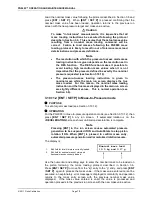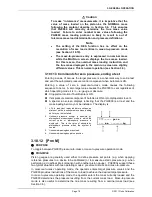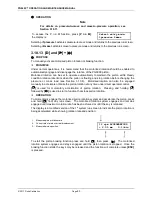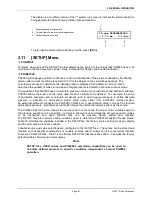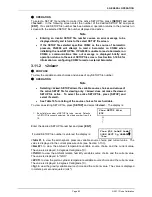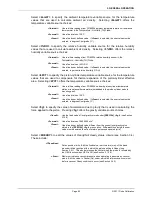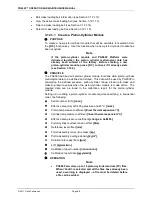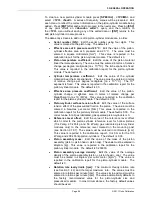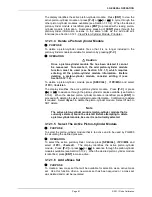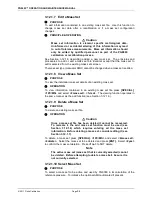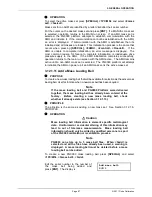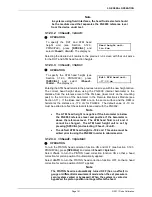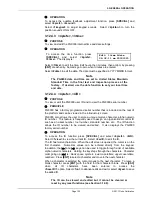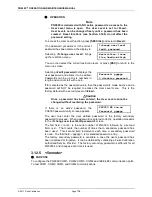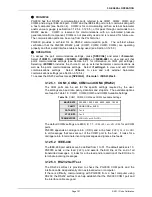
PG9602™ OPERATION AND MAINTENANCE MANUAL
© 2011 Fluke Calibration
Page
92
Note
If the mass set and PG9000 Platform were delivered together,
the mass set data was entered at the factory. Before creating a
new mass set, check whether it already exists using the view
mass set function (see Section 3.12.1.8).
PRINCIPLE
The PG9000 add and edit mass set functions allow mass set composition and
metrological data to be defined and stored. These values will be used by
PG9000 when the mass set is made active to calculate nominal mass
instructions and true mass loads. Up to three mass sets can be stored.
Setting up or editing a mass set requires defining the density of the masses, the
mass set composition and the true mass
Note
value of each individual mass. This
information can be found in the calibration report for the mass set.
The calculated reference pressure is based on using True Mass
values – do not use apparent mass values when defining a
mass set.
Mass sets are created and edited in terms of mass groups reflecting the normal
composition of a PG9000 mass set. Standard PG9000 mass sets are made up
of these groups (see Section 2.1.2.2 for listings of standard PG9000 mass
set compositions, and Section 3.6 on the theory of mass loading protocol).
The mass groups of a
MANUAL
mass set include:
1.
Make Up mass (4 or 9 kg)
: A single mass, sequentially numbered 1.
The value of this mass is 9 kg if the mass set main masses are 10 kg and
4 kg if the mass set main masses are 5 kg. The purpose of this mass is to
arrive at a whole number nominal mass load equal to the set’s main masses
(10 kg or 5 kg) when added to the piston and mass loading bell.
2.
10 kg masses
: The main masses in a standard 80 or 100 kg mass set.
Sequentially numbered from 1 up to the total number of 10 kg masses.
Mass sets of less than 80 kg do not normally include 10 kg masses.
3.
5 kg masses
:
The main masses in any standard mass set of less than
80 kg. Sequentially numbered from 1 up to the total number of 5 kg masses.
Standard 80 and 100 kg mass sets have one 5 kg mass.
4.
2 kg masses
:
Every standard mass set has two 2 kg masses numbered 1
and 2.
5.
1 kg masses
:
Every standard mass set has one 1 kg mass numbered 1.
6.
0.5 kg masses
: Every standard mass set has one 0.5 kg mass number 1.
7.
0.2 kg masses
: Every standard mass set has two 0.2 kg masses numbered 1
and 2.
8.
0.1 kg masses
: Every standard mass set has one 0.1 kg mass numbered 1.
9.
Trim masses
: Every standard mass set has a trim mass set made up of
masses from 50 to 0.01 g. These masses are NOT defined and entered as
part of the mass set.
The mass groups for an
AMH
mass set include:
1.
10.1 kg Main masses
: Sequentially numbered from 1 to a maximum of 9.
2.
6.4 kg mass
:
Single tubular, binary mass.
3.
3.2 kg mass
: Single tubular, binary mass.
4.
1.6 kg mass
: Single tubular, binary mass.
5.
0.8 kg mass
: Single tubular, binary mass.
6.
0.4 kg mass
: Single tubular, binary mass.
Summary of Contents for PG9000 Series
Page 10: ...PG9602 OPERATION AND MAINTENANCE MANUAL 2011 Fluke Calibration Page X Notes...
Page 128: ...PG9602 OPERATION AND MAINTENANCE MANUAL 2011 Fluke Calibration Page 118 Notes...
Page 164: ...PG9602 OPERATION AND MAINTENANCE MANUAL 2011 Fluke Calibration Page 154 Notes...
Page 188: ...PG9602 OPERATION AND MAINTENANCE MANUAL 2011 Fluke Calibration Page 178 Notes...
Page 192: ...PG9602 OPERATION AND MAINTENANCE MANUAL 2011 Fluke Calibration Page 182 Notes...

